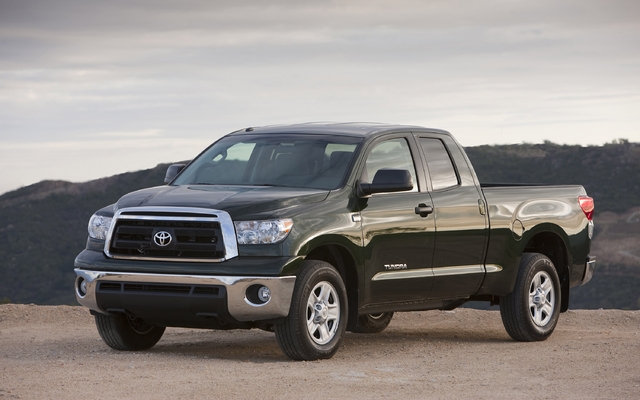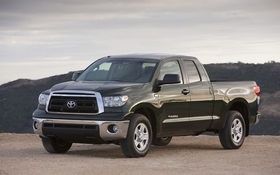2011 Toyota Tundra: As Big as The Tundra Itself

| Strong points |
|
|---|---|
| Weak points |
|
The introduction to a car review is always the hardest part to write. You want to hook the reader in with something witty and informative, but you don’t want to fall back on some lame, overused colloquial quip. So, this is where I won’t talk about the ridiculous fervor surrounding this truck’s launch a few years ago, or its struggle to follow through on that excitement as a result of the truck market’s stalwart brand loyalty.
Instead, I’ll cut straight to the chase: this is one big truck. Having a fair amount of experience driving a variety of trucks both great and small, the Tundra’s girth is almost otherworldly. Although intended to compete with other half-ton trucks like the F-150 and Ram 1500, the Tundra’s appears to be an XXL in an already plus-sized market. The upright grill stands chest-high, and a desire to maximize interior spaciousness ensures that the cab is almost astronomically large when viewed from outside. Although none of its competitors are small by any stretch, the Tundra’s various design features are almost caricatures of their normal selves: the headlights and grill dominating the many square feet of frontal area and the stylish creases adorning the flanks almost looking more like rolls, if you know what I mean. Grabbing the massive door handles with regular-sized hands, you can’t help but feel a little bit less masculine as you wonder if Paul Bunyan had some degree of input on the truck’s appearance.
It’s no different inside. The view over the domed hood is, at first blush, downright intimidating. Although it is actually quite short, the sloping nature of the truck’s front end doesn’t give one a lot of confidence as to where precisely it ends, making tight parking lots and heavy traffic a little nail-biting. As for width, well, narrow door panels and a wide centre console make it feel as if the seats have been positioned a wee bit farther apart than in American trucks, which does make the truck feel a bit wider. Once you get used to it though, that sense of being further outboard gives a good impression of where the truck’s flanks are, making narrow lanes a bit easier to negotiate.
Once I’d gotten used to the truck’s sense of the immense, I rapidly started to notice that within the confines of this jumbo-sized pickup truck, there’s a lot to like. Although not quite as upscale as a well-equipped F-150 or new Ram, the Tundra’s interior is very well rendered and feels quite workable, for lack of a better word. The seats are all-day comfortable and upholstered in nice fabric (a plus, in my books), and the seating position is incredibly natural. The dashboard, although being somewhat far away, is well laid out and all the most important controls find themselves replicated on the steering wheel, so there aren’t many occasions in which you end up searching the big, silver dashboard for a button. But ironically, it’s really the size that makes it so great.
From the footwells to the headroom to the dual gloveboxes, there’s simply nowhere in which the Tundra pinches, squeezes, or encroaches upon your personal bubble. Passengers may as well be in the next time zone, and that’s not a bad thing sometimes. And you won’t find any of your personal effects taking up too much space either, what with the plethora of storage bins, nooks, and crannies at your disposal. From the driver’s seat, there are countless cupholders with additional storage beneath them, a storage bin topped with a tray between the cupholders and shifter, and of course, the cavernous centre console. In the door panel, yet another deep, wide bin resides at the bottom of the door, complimented by an additional bin that opens up beneath the window switches. And although some of those spaces may be shared with the passenger, chances are good the passenger won’t need them, what with the two massive gloveboxes offered. Larger parcels are easily stowed in or under the rear seat. And only once all these options have been exhausted will you find yourself placing things in the bed.
And in the off chance that you can’t yet get everything in the Tundra, well, making multiple trips will be unbelievably quick with the optional 5.7L V8. Although the total power output may not be the class-leading figure that it once was, the ground gained by the competition doesn’t diminish the big V8’s awe-inspiring potency. Cruising the highways and byways of the Lower Mainland, the 5.7 was quiet and quite tractable, and sounds great. But it’s when you get on it a wee bit that you start to understand why this engine was, and still is, so highly regarded. There’s none of the lazy, laggardly behavior typically associated with torque-converter equipped trucks, instead replaced by ferocious power and torque that seems to punish the back tires with its immediacy.
But does this really matter? Well, of course it does. Granted, the Tundra hasn’t reached the sales level it was slated to, but it did put the truck market on notice. Even without selling at the rate of Ford’s venerable F-150 or Chevy’s Silverado, Toyota’s Tundra managed to convince truck buyers that they needn’t accept the long held beliefs that trucks need to be the slow workhorses of old. And sure, the Americans were moving away from that model already, but not at a pace that matched Toyota’s. So, even if duking it out in the full-size truck market might be an uphill fight for the Tundra, there can be no denying its effect on the battlefield.











